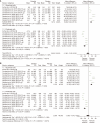Efficacy and Safety of Intravaginal Estrogen in the Treatment of Atrophic Vaginitis: A Systematic Review and Meta-Analysis
- PMID: 39315501
- PMCID: PMC11439571
- DOI: 10.6118/jmm.23037
Efficacy and Safety of Intravaginal Estrogen in the Treatment of Atrophic Vaginitis: A Systematic Review and Meta-Analysis
Abstract
Objectives: Postmenopausal females often experience genitourinary symptoms like vulvovaginal dryness due to estrogen decline. Hormone replacement therapy is effective in alleviating vaginal atrophy and genitourinary syndrome in this population. Evaluate local estrogen's safety and effectiveness for alleviating postmenopausal vaginal symptoms, including endometrial thickness, dyspareunia, vaginal pH, and dryness.
Methods: We searched Google Scholar, Cochrane Library, ClinicalTrial.Gov, PubMed, and ScienceDirect databases until July 2023. All randomized controlled trials (RCTs) linking intravaginal estrogen supplementation to vaginal atrophy or vaginitis were included. The risk of bias was evaluated with RoB 2, and publication bias was assessed using Egger and Beggs analysis.
Results: All evidence pertains to females. Eighteen studies (n = 4,723) compared estrogen with placebo. Patients using estrogen showed a significant increase in superficial cells (mean differences [MD]: 19.28; 95% confidence intervals [CI]: 13.40 to 25.16; I² = 90%; P < 0.00001) and a decrease in parabasal cells (MD: -24.85; 95% CI: -32.96 to -16.73; I² = 92%; P < 0.00001). Vaginal pH and dyspareunia significantly reduced in estrogen users (MD: -0.94; 95% CI: -1.05 to -0.84; I² = 96%) and (MD: -0.52; 95% CI: -0.63 to -0.41; I² = 99%), respectively. Estrogen did not significantly affect vaginal dryness (MD: -0.04; 95% CI: -0.18 to 0.11; I² = 88%). Adverse events like vulvovaginal pruritis, mycotic infection, and urinary tract infection were reported, but the association was insignificant (risk ratio: 0.95; 95% CI: 0.88 to 1.02; I² = 0%).
Conclusions: Our meta-analysis of 18 RCTs suggests promising potential for intravaginal estrogen therapy in alleviating vaginal atrophy and vaginitis in postmenopausal females.
Keywords: Estradiol; Maturation value; Postmenopausal women; Vaginal atrophy; Vaginal pH.
Copyright © by The Korean Society of Menopause.
Conflict of interest statement
No potential conflict of interest relevant to this article was reported.
Figures




References
-
- Campbell S, Whitehead M. Oestrogen therapy and the menopausal syndrome. Clin Obstet Gynaecol. 1977;4:31–47. - PubMed
-
- Suckling J, Lethaby A, Kennedy R. Local oestrogen for vaginal atrophy in postmenopausal women. Cochrane Database Syst Rev. 2006;4:CD001500 - PubMed
-
- Heimer G, Englund D. Estriol: absorption after long-term vaginal treatment and gastrointestinal absorption as influenced by a meal. Acta Obstet Gynecol Scand. 1984;63:563–567. - PubMed
-
- Smith RN, Studd JW. Recent advances in hormone replacement therapy. Br J Hosp Med. 1993;49:799–808. - PubMed
LinkOut - more resources
Full Text Sources

